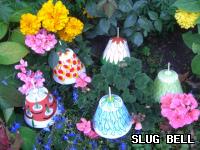How to Control Slugs and Snails
 Slugs are one of the top garden pests in the UK
Slugs are one of the top garden pests in the UKInventor of the slugbell; Michael Messina gives some expert advice on combating these common garden pests.
Slugs and snails are the most prolific pests that gardeners have to compete against when trying to create and maintain a beautiful garden. These slimy pests can devour plants overnight especially those that have nice lush leaves such as Hostas, Lettuce, Delphiniums and French Marigolds. During the day slugs and snails tend to hide away from their predators in damp, dark places around the garden.
Each cubic metre of garden will contain up to 200 slugs, that's an average of 4,000 slugs per average garden. Only 5% of the slugs in a garden are found above ground, the other 95% are below the soil surface digesting their meal, laying more eggs and feeding on roots and juvenile plant growth that is yet to break the surface of the soil and probaly never will if the slugs and snails get to them first.
Slugs and snails actually both have shells. Slugs' shells are much smaller and not visible as they are underneath the flesh on their back. Slug eggs are in the soil just about everywhere. They can lay dormant in the soil for many years and then hatch when conditions are right. It actually takes moisture to allow them to hatch. Slugs can lay between 400 to 600 eggs per year.
Controlling Slugs

There are numerous slug control methods that have been around for decades i.e. Copper bands, Egg shells, Coffee grounds, Beer wells and Slug pellets.
Slug pellets are highly poisonous to cats,dogs, birds and other wildlife, and also our precious environment.
And as a keen gardener I felt that this continuous poisoning of the soil and the battle with slugs was never ending until my Eureka day. That was when my wife washed and washed a lettuce but a small piece of a slug pellet was on the inside of a leaf and I ate it! The taste was absolutely disgusting. I was not a happy bunny…so I went into my shed and started to work on a few ideas. That was back in 1999, after I made a few prototypes which worked, I gave them to fellow gardeners to try with great results. It was only in late 2009 that I started to work on a design that is now the Slugbell.
The Slugbell is on a spike so that it is raised above the soil surface. Within the bell there is a small round mesh basket containing a small amount of pellets, this keeps pellets dry and away from the earth thus preventing the pellets being washed away into the soil.

I took the Slugbell to the RHS Hampton Court flower show and it was agreat success, I had lots of editorial from British and International high street garden magazines, acknowledgement from HRH Prince Charles and High Grove House and interest from small and large garden centres. With all the on-going enquiries I feel that I have invented “The World’s Safest & Best Slug Control Device” It protects children, pets, birds, the environment, it is made of metal and it has a highly attractive flower pattern.
Rain, dampness, drizzle, or mist do not affect the Slugbell and the small amount of slug pellets needed will last for around 8 weeks so you can go on holiday and still come back to a slug free garden.
For more information visit the Slugbell website.
Article posted on 01 Mar 2012.

